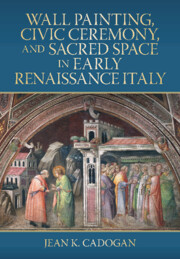Refine search
Actions for selected content:
337 results
19 - Sacraments
- from Part II - Theological Themes
-
-
- Book:
- The Origins of Scholasticism
- Published online:
- 18 November 2025
- Print publication:
- 08 January 2026, pp 519-550
-
- Chapter
- Export citation
Chapter 14 - Herodotus
- from Part III - Individuals
-
-
- Book:
- Personal Religion in the Ancient Greek World
- Published online:
- 25 November 2025
- Print publication:
- 11 December 2025, pp 321-337
-
- Chapter
- Export citation
Chapter 13 - Curse Tablets, Amulets, and Spells
- from Part II - Beliefs and Practices
-
-
- Book:
- Personal Religion in the Ancient Greek World
- Published online:
- 25 November 2025
- Print publication:
- 11 December 2025, pp 296-318
-
- Chapter
- Export citation
12 - The Imperial Romance
- from Part II - Entanglements of Prose, Poetry, and Empire: 1800–1900
-
-
- Book:
- The Cambridge Companion to British Literature and Empire
- Published online:
- 20 November 2025
- Print publication:
- 04 December 2025, pp 174-186
-
- Chapter
- Export citation
Case 3
-
- Book:
- Debating Papal History, c. 250–c. 1300
- Published online:
- 03 November 2025
- Print publication:
- 20 November 2025, pp 53-59
-
- Chapter
- Export citation
7 - ‘In the Forest We Don’t Accept the Grace of God’
-
- Book:
- The Making of Brazilian Amazonian Societies
- Published online:
- 14 November 2025
- Print publication:
- 20 November 2025, pp 250-291
-
- Chapter
- Export citation
Pervasive Ritual at Wroxeter: The Evidence of the Buried Ceramics from the Bushe-Fox Excavations 1912–14
-
- Journal:
- Britannia , First View
- Published online by Cambridge University Press:
- 19 November 2025, pp. 1-38
-
- Article
- Export citation
3 - Against the Galileans II
-
- Book:
- The Narrative Conflict of Traditions in the Late Antique World
- Published online:
- 22 September 2025
- Print publication:
- 09 October 2025, pp 99-118
-
- Chapter
- Export citation
21 - Liturgy as Ritual (and Prayer)
- from Part V - The Study of Liturgy
-
-
- Book:
- The Cambridge Companion to Christian Liturgy
- Published online:
- 19 September 2025
- Print publication:
- 09 October 2025, pp 369-388
-
- Chapter
- Export citation

Wall Painting, Civic Ceremony, and Sacred Space in Early Renaissance Italy
-
- Published online:
- 19 September 2025
- Print publication:
- 23 October 2025

Death Rituals
- The Rūs and 'Vikings' in Arabic and Persian
-
- Published online:
- 13 September 2025
- Print publication:
- 09 October 2025
-
- Element
- Export citation
2 - Healing and Ritual on the Move
- from Part I - Black Geographies
-
- Book:
- Black Catholic Worlds
- Published online:
- 28 August 2025
- Print publication:
- 11 September 2025, pp 81-122
-
- Chapter
- Export citation
Chapter 11 - Religion
- from Part II - Themes and Issues
-
-
- Book:
- The Cambridge Companion to Modernist Theatre
- Published online:
- 28 August 2025
- Print publication:
- 11 September 2025, pp 198-216
-
- Chapter
- Export citation
Estimated costs and benefits of participation in an extreme ritual in Mauritius
-
- Journal:
- Evolutionary Human Sciences / Volume 7 / 2025
- Published online by Cambridge University Press:
- 22 August 2025, e29
-
- Article
-
- You have access
- Open access
- HTML
- Export citation
Chapter 2 - Sin, Sacrifice, and Atonement (Leviticus 1–7, 16)
-
- Book:
- The Theology of the Book of Leviticus
- Published online:
- 18 July 2025
- Print publication:
- 07 August 2025, pp 32-82
-
- Chapter
- Export citation
4 - Potnia of the Labyrinth, Initiation of the King, and the Triple Sacrifice
-
- Book:
- Myth, Ritual, and Society in Mycenaean Anatolia
- Published online:
- 18 July 2025
- Print publication:
- 07 August 2025, pp 131-161
-
- Chapter
- Export citation
2 - Mycenaean and Vedic Sacrificial Posts
-
- Book:
- Myth, Ritual, and Society in Mycenaean Anatolia
- Published online:
- 18 July 2025
- Print publication:
- 07 August 2025, pp 47-66
-
- Chapter
- Export citation
6 - Nart Saga, Indo-Iranian Twins, and Dioscurias
-
- Book:
- Myth, Ritual, and Society in Mycenaean Anatolia
- Published online:
- 18 July 2025
- Print publication:
- 07 August 2025, pp 194-237
-
- Chapter
- Export citation
7 - Golden Fleeces
-
- Book:
- Myth, Ritual, and Society in Mycenaean Anatolia
- Published online:
- 18 July 2025
- Print publication:
- 07 August 2025, pp 238-272
-
- Chapter
- Export citation
5 - Mitannian and Anatolian Triads
-
- Book:
- Myth, Ritual, and Society in Mycenaean Anatolia
- Published online:
- 18 July 2025
- Print publication:
- 07 August 2025, pp 162-193
-
- Chapter
- Export citation
